Loading...
13 min read

In the dynamic world of modern applications, efficient load balancing plays a pivotal role in delivering exceptional user experiences. Customers commonly leverage load balancing, so they can efficiently use their existing infrastructure resources in the best way possible. Though, load balancing is not a ‘one-size-fits-all, out of the box’ solution for everyone. As you go deeper into the details of your traffic shaping requirements and as your architecture becomes more complex, different flavors of load balancing are usually required to achieve these varying goals, such as steering between datacenters for public traffic, creating high availability for critical internal services with private IPs, applying steering between servers in a single datacenter, and more. We are extremely excited to announce a new addition to our Load Balancing solution, Local Traffic Management (LTM) with deep integrations with Zero Trust!
A common problem businesses run into is that almost no providers can satisfy all these requirements, resulting in a growing list of vendors to manage disparate data sources to get a clear view of your traffic pipeline, and investment into incredibly expensive hardware that is complicated to set up and maintain. Not having a single source of truth to dwindle down ‘time to resolution’ and a single partner to work with in times when things are not operating within the ideal path can be the difference between a proactive, healthy growing business versus one that is reactive and constantly having to put out fires. The latter can result in extreme slowdown to developing amazing features/services, reduction in revenue, tarnishing of brand trust, decreases in adoption - the list goes on!
For eight years, we have provided top-tier global traffic load balancing (GTM) capabilities to thousands of customers across the globe. But why should the steering intelligence, failover, and reliability we guarantee stop at the front door of the selected datacenter and only operate with public traffic? We came to the conclusion that we should go even further. Today is the start of a long series of new features that allow traffic steering, failover, session persistence, SSL/TLS offloading and much more to take place between servers after datacenter selection has occurred! Instead of relying only on the relative weight to determine which server traffic should be sent to, you can now bring the same intelligent steering policies, such as least outstanding requests steering or hash steering, to any of your many data centers. This also means you have a single partner for all of your load balancing initiatives and a single pane of glass to inform business decisions! Cloudflare is thrilled to introduce the powerful combination of private IP support for Load Balancing with Cloudflare Tunnels and Local Traffic Management, offering customers a solution that blends unparalleled efficiency, security, flexibility, and privacy.
What is a load balancer?

Load balancing — functionality that’s been around for the last 30 years to help businesses leverage their existing infrastructure resources. Load balancing works by proactively steering traffic away from unhealthy origin servers and — for more advanced solutions — intelligently distributing traffic load based on different steering algorithms. This process ensures that errors aren’t served to end users and empowers businesses to tightly couple overall business objectives to their traffic behavior. Cloudflare Load Balancing has made it simpler and easier to securely and reliably manage your traffic across multiple data centers around the world. With Cloudflare Load Balancing, your traffic will be directed reliably regardless of the scale of traffic or where it originates with customizable steering, affinity and failover. This clearly has an advantage over a physical load balancer since it can be configured easily and traffic doesn’t have to reach one of your data centers to be routed to another location, introducing single points of failure and significant latency. When compared with other global traffic management load balancers, Cloudflare’s Load Balancing offering is easier to set up, simpler to understand, and is fully integrated with the Cloudflare platform as one single product for all load balancing needs.
What are Cloudflare Tunnels?
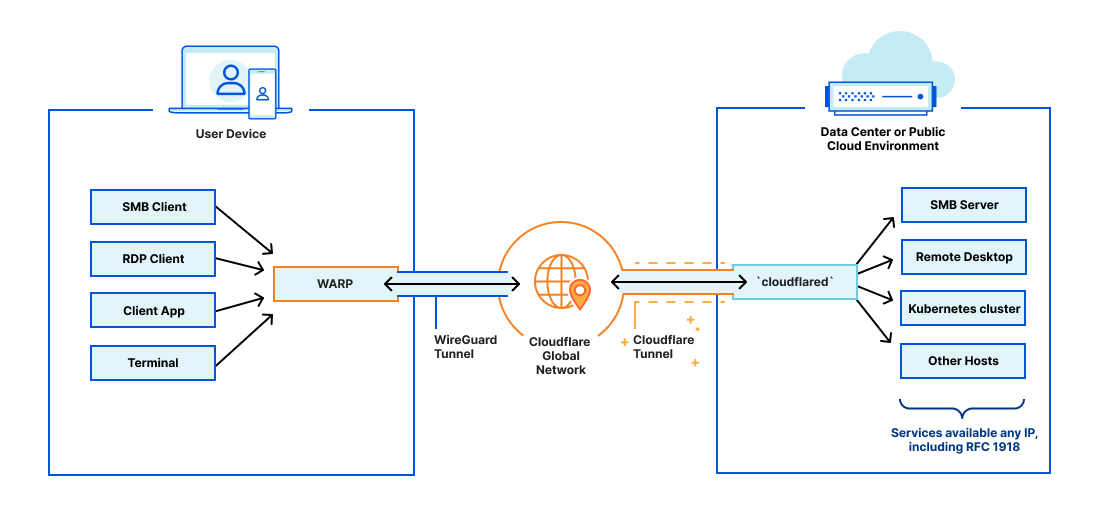
In 2018, Cloudflare introduced Cloudflare Tunnels, a private, secure connection between your data center and Cloudflare. Traditionally, from the moment an Internet property is deployed, developers spend an exhaustive amount of time and energy locking it down through access control lists, rotating IP addresses, or more complex solutions like GRE tunnels. We built Tunnel to help alleviate that burden. With Tunnels, users can create a private link from their origin server directly to Cloudflare without exposing your services directly to the public internet or allowing incoming connections in your data center’s firewall. Instead, this private connection is established by running a lightweight daemon, cloudflared, in your data center, which creates a secure, outbound-only connection. This means that only traffic that you’ve configured to pass through Cloudflare can reach your private origin.
Unleashing the potential of Cloudflare Load Balancing with Cloudflare Tunnels
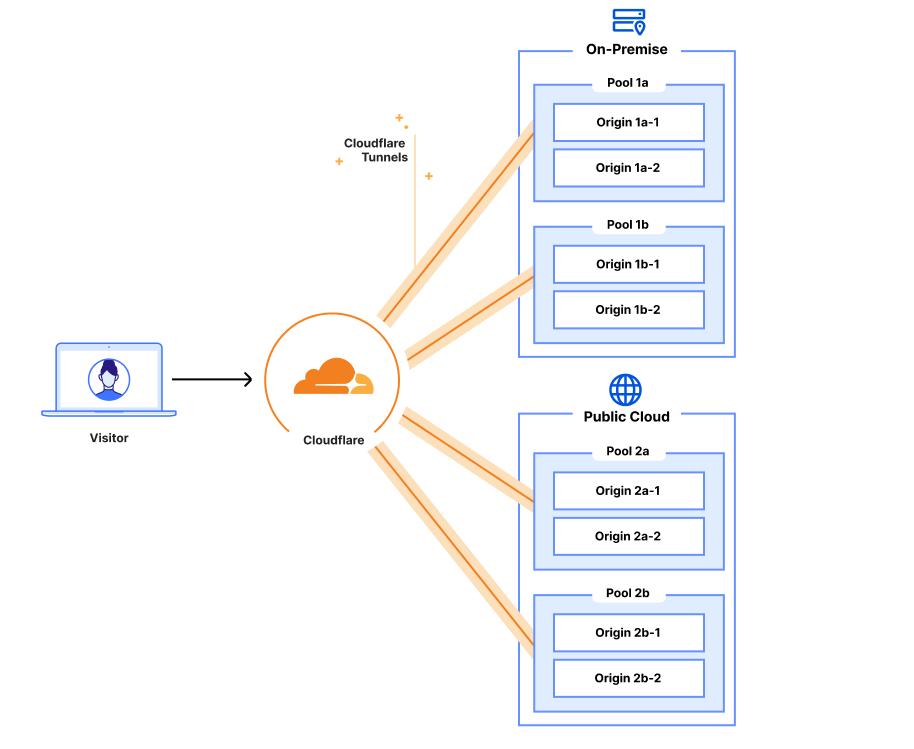
Combining Cloudflare Tunnels with Cloudflare Load Balancing allows you to remove your physical load balancers from your data center and have your Cloudflare load balancer reach out to your servers directly via their private IP addresses with health checks, steering, and all other Load Balancing features currently available. Instead of configuring your on-premise load balancer to expose each service and then updating your Cloudflare load balancer, you can configure it all in one place. This means that from the end-user to the server handling the request, all your configuration can be done in a single place – the Cloudflare dashboard. On top of this, you can say goodbye to the multi hundred thousand dollar price tag to hardware appliances, the incredible management overhead and investing in a solution that has a time limit for its delivered value.
Load Balancing serves as the backbone for online services, ensuring seamless traffic distribution across servers or data centers. Traditional load balancing techniques often require exposing services on a data center’s public IP addresses, forcing organizations to create complex configurations vulnerable to security risks and potential data exposure. By harnessing the power of private IP support for Load Balancing in conjunction with Cloudflare Tunnels, Cloudflare is revolutionizing the way businesses protect and optimize their applications. With clear steps to install the cloudflared agent to connect your private network to Cloudflare’s network via Cloudflare Tunnels, directly and securely routing traffic into your data centers becomes easier than ever before!
Publicly exposing services in private data centers is complicated
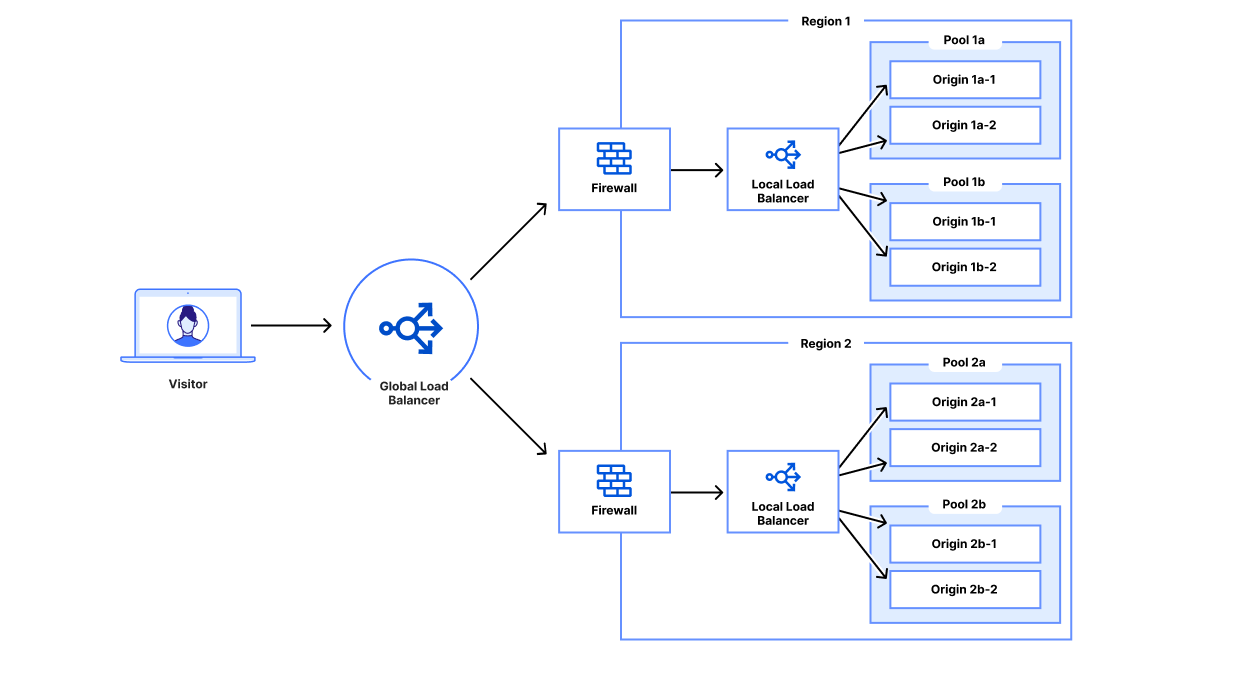
Load balancing within a private data center can be expensive and difficult to manage. The idea of keeping security first while ensuring ease of use and flexibility for your internal workforce is a tricky balance to strike. It’s not only the ‘how’ of securely exposing internal services, but how to best balance traffic between servers at a single location within your private network!
In a private data center, even a very simple website can be fairly complex in terms of networking and configuration. Let’s walk through a simple example of a customer device connecting to a website. A customer device performs a DNS lookup for the business’s website and receives an IP address corresponding to a customer data center. The customer then makes an HTTPS request to that IP address, passing the original hostname via Server Name Indication (SNI). That load balancer forwards that request to the corresponding origin server and returns the response to the customer device.
This example doesn’t have any advanced functionality and the stack is already difficult to configure:
- Expose the service or server on a private IP.
- Configure your data center’s networking to expose the LB on a public IP or IP range.
- Configure your load balancer to forward requests for that hostname and/or public IP to your server’s private IP.
- Configure a DNS record for your domain to point to your load balancer’s public IP.
In large enterprises, each of these configuration changes likely requires approval from several stakeholders and modified through different repositories, websites and/or private web interfaces. Load balancer and networking configurations are often maintained as complex configuration files for Terraform, Chef, Puppet, Ansible or a similar infrastructure-as-code service. These configuration files can be syntax checked or tested but are rarely tested thoroughly prior to deployment. Each deployment environment is often unique enough that thorough testing is often not feasible given the time and hardware requirements needed to do so. This means that changes to these files can negatively affect other services within the data center. In addition, opening up an ingress to your data center widens the attack surface for varying security risks such as DDoS attacks or catastrophic data breaches. To make things worse, each vendor has a different interface or API for configuring their devices or services. For example, some registrars only have XML APIs while others have JSON REST APIs. Each device configuration may have different Terraform providers or Ansible playbooks. This results in complex configurations accumulating over time that are difficult to consolidate or standardize, inevitably resulting in technical debt.
Now let’s add additional origins. For each additional origin for our service, we’ll have to go set up and expose that origin and configure the physical load balancer to use our new origin. Now let’s add another data center. Now we need another solution to distribute across our data centers. This results in a separate global traffic management system and local traffic management system. These solutions have in the past come from different vendors and will have to be configured in different ways even though they should serve the same purpose: load balancing. This makes managing your web traffic unnecessarily difficult. Why should you have to configure your origins in two different load balancers? Why can’t you manage all the traffic for all the origins for a service in the same place?
Simpler and better: Load Balancing with Tunnels
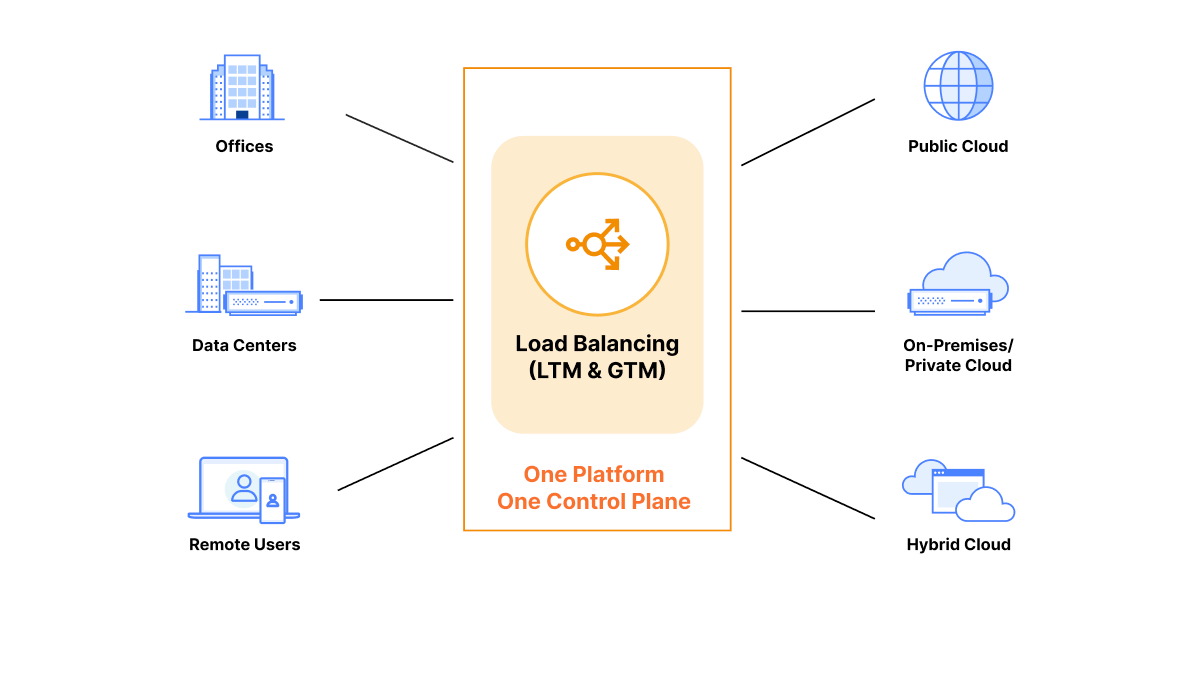
With Cloudflare Load Balancing and Cloudflare Tunnel, you can manage all your public and private origins in one place: the Cloudflare dashboard. Cloudflare load balancers can be easily configured using the Cloudflare dashboard or the Cloudflare API. There’s no need to SSH or open a remote desktop to modify load balancer configurations for your public or private servers. All configurations can be done through the dashboard UI or Cloudflare API, with full parity between the two.
With Cloudflare Tunnel set up and running in your data center, everything is ready to connect your origin server to Cloudflare network and load balancers. You do not need to configure any ingress to your data center since Cloudflare Tunnel operates only over outbound connections and can securely reach out to privately addressed services inside your data center. To expose your service to Cloudflare, you just set up your private IP range to be routed over that tunnel. Then, you can create a Cloudflare load balancer and input the corresponding private IP address and virtual network ID into your origin pool. After that, Cloudflare manages the DNS and load balancing across your private servers. Now your origin is receiving traffic exclusively via Cloudflare Tunnel and your physical load balancer is no longer needed!
This groundbreaking integration enables organizations to deploy load balancers while keeping their applications securely shielded from the public Internet. The customer’s traffic passes through Cloudflare’s data centers, allowing customers to continue to take full advantage of Cloudflare’s security and performance services. Also, by leveraging Cloudflare Tunnels, traffic between Cloudflare and customer origins remains isolated within trusted networks, bolstering privacy, security, and peace of mind.
The advantages of Private IP support with Cloudflare Tunnels
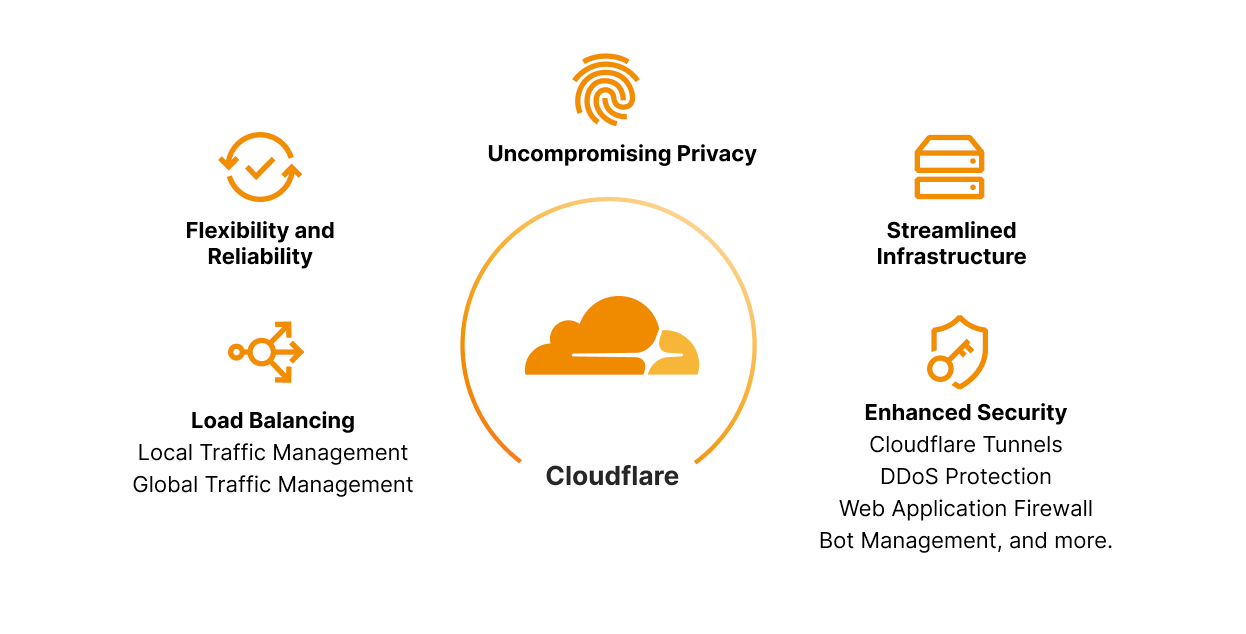
Combining Global and Local Traffic Management: All the features and ease of use that were part of Cloudflare Load Balancing for Global Traffic Management are also available with Local Traffic Management. You can configure your public and private origins in one dashboard as opposed to several services and vendors. Now, all your private origins can benefit from the features that Cloudflare Load Balancing is known for: instant failover, customizable steering between data centers, ease of use, custom rules and configuration updates in a matter of seconds. They will also benefit from our newer features including least connection steering, least outstanding request steering, and session affinity by header. This is just a small subset of the expansive feature set for Load Balancing. See our dev docs for more features and details on the offering.
Enhanced Security: By combining private IP support with Cloudflare Tunnels, organizations can fortify their security posture and protect sensitive data. With private IP addresses and encrypted connections via Cloudflare Tunnel, the risk of unauthorized access and potential attacks is significantly reduced – traffic remains within trusted networks. You can also configure Cloudflare Access to add single sign-on support for your application and restrict your application to a subset of authorized users. In addition, you still benefit from Firewall rules, Rate Limiting rules, Bot Management, DDoS protection and all the other Cloudflare products available today allowing comprehensive security configurations.
Uncompromising Privacy: As data privacy continues to take center stage, businesses must ensure the confidentiality of user information. Cloudflare's private IP support with Cloudflare Tunnels enables organizations to segregate applications and keep sensitive data within their private network boundaries. Custom rules also allow you to direct traffic for specific devices to specific data centers. For example, you can use custom rules to direct traffic from Eastern and Western Europe to your European data centers, so you can easily keep those users’ data within Europe. This minimizes the exposure of data to external entities, preserving user privacy and complying with strict privacy regulations across different geographies.
Flexibility & Reliability: Scale and adaptability are some of the major foundations of a well-operating business. Implementing solutions that fit your business’ needs today is not enough. Customers must find solutions that meet their needs for the next three or more years. The blend of Load Balancing with Cloudflare Tunnels within our Zero Trust solution lends to the very definition of flexibility and reliability! Changes to load balancer configurations propagate around the world in a matter of seconds, making load balancers an effective way to respond to incidents. Also, instant failover, health monitoring, and steering policies all help to maintain high availability for your applications, so you can deliver the reliability that your users expect. This is all in addition to best in class Zero Trust capabilities that are deeply integrated such as, but not limited to Secure Web Gateway (SWG), remote browser isolation, network logs. Data loss prevention.
Streamlined Infrastructure: Organizations can consolidate their network architecture and establish secure connections across distributed environments. This unification reduces complexity, lowers operational overhead, and facilitates efficient resource allocation. Whether you need to apply a global traffic manager to intelligently direct traffic between datacenters within your private network, or steer between specific servers after datacenter selection has taken place, there is now a clear, single lens to manage your global and local traffic, regardless of whether the source or destination of the traffic is public or private. Complexity can be a large hurdle in achieving and maintaining fast, agile business units. Consolidating into a single provider, like Cloudflare, that provides security, reliability, and observability will not only save significant cost but allows your teams to move faster and focus on growing their business, enhancing critical services, and developing incredible features, rather than taping together infrastructure that may not work in a few years. Leave the heavy lifting to us, and let us empower you and your team to focus on creating amazing experiences for your employees and end-users.
The lack of agility, flexibility, and lean operations of hardware appliances for Local Traffic Management does not justify the hundreds of thousands of dollars spent on them, along with the huge overhead of managing CPU, memory, power, cooling, etc. Instead, we want to help businesses move this logic to the cloud by abstracting away the needless overhead and bringing more focus back to teams to do what they do best, building amazing experiences, and allowing Cloudflare to do what we do best, protecting, accelerating, and building heightened reliability. Stay tuned for more updates on Cloudflare's Local Traffic Manager and how it can reduce architecture complexity while bringing more insight, security, and control to your teams. In the meantime, check out our new whitepaper!
Looking to the future
Cloudflare's impactful solution, private IP support for Load Balancing with Cloudflare Tunnels as part of the Zero Trust solution, reaffirms our commitment to providing cutting-edge tools that prioritize security, privacy, and performance. By leveraging private IP addresses and secure tunnels, Cloudflare empowers businesses to fortify their network infrastructure while ensuring compliance with regulatory requirements. With enhanced security, uncompromising privacy, and streamlined infrastructure, load balancing becomes a powerful driver of efficient and secure public or private services.
As a business grows and its systems scale up, they'll need the features that Cloudflare Load Balancing is known for: health monitoring, steering, and failover. As availability requirements increase due to growing demands and standards from end-users, customers can add health checks, enabling automatic failover to healthy servers when an unhealthy server begins to fail. When the business begins to receive more traffic from around the world, they can create new pools for different regions and use dynamic steering to reduce latency between the user and the server. For intensive or long-running requests, such as complex datastore queries, customers can benefit from leveraging least outstanding requests steering to reduce the number of concurrent requests per server. Before, this could all be done with publicly addressable IPs, but it is now available for pools with public IPs, private servers, or combinations of the two. Private IP Load Balancing along with Local Traffic Management is live and ready to use today! Check out our dev docs for instructions on how to get started.
Stay tuned for our next addition to add new Load Balancing onramp support for Spectrum and WARP with Cloudflare Tunnels with private IPs for your Layer 4 traffic, allowing us to support TCP and UDP applications in your private data centers!
We protect entire corporate networks, help customers build Internet-scale applications efficiently, accelerate any website or Internet application, ward off DDoS attacks, keep hackers at bay, and can help you on your journey to Zero Trust.
Visit 1.1.1.1 from any device to get started with our free app that makes your Internet faster and safer.
To learn more about our mission to help build a better Internet, start here. If you're looking for a new career direction, check out our open positions.


